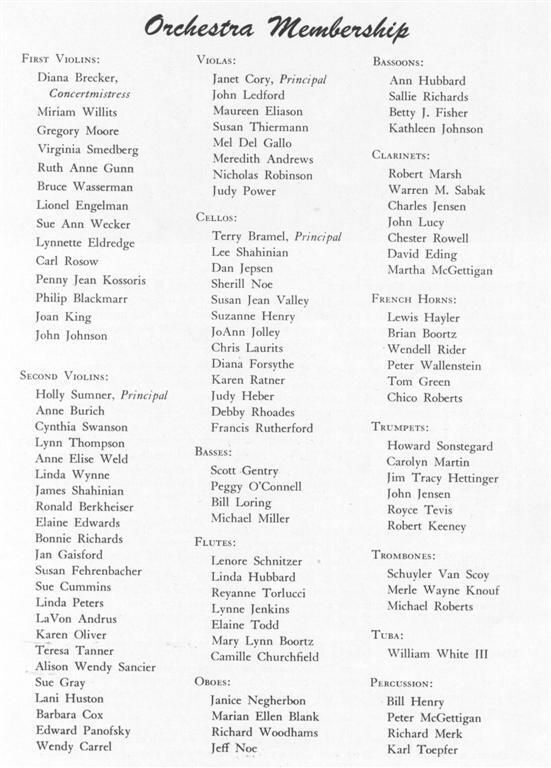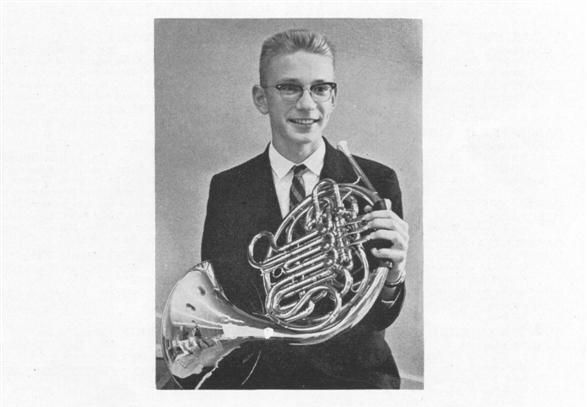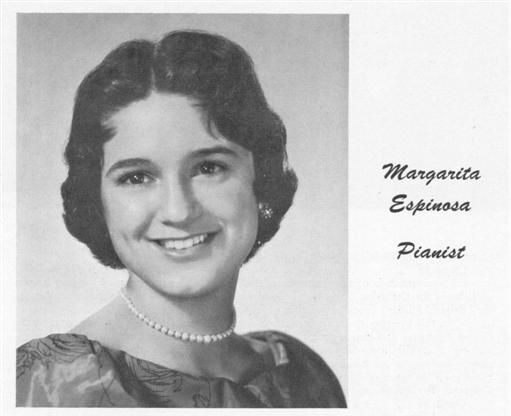Season 10
1961-1962
Roster



October 1961 Concert
Concert Program and Review
CYS 1961 Concert, conducted by Aaron Sten, presented a program that included Beethoven's Symphony No. 3 in E flat major, "The Eroica," and Mozart's Concerto No. 2 for Horn and Orchestra. The program also featured the Prelude from "Die Meistersinger" by Richard Wagner and Malaguena from the Andalucia Suite Espagnole by Ernesto Lecuona.
The concert took place on a Sunday afternoon in October at Holy Cross School in Mountain View and was later repeated at San Mateo High School.
Concert Review Highlights (By Dorothy Nichols)
The performance of the "Eroica" was highly praised, with the review noting that the youth group played the work "superbly." The orchestra maintained vigor and audiences were thrilled despite the heat. The interpretation of the "Eroica" was "being commended." The orchestra’s playing of the "Funeral March" movement was cited as particularly challenging and well-sustained. The review emphasized that the music "stood by itself, to be heard for itself, for the pace and drive of the symphony."
The ensemble's performance was characterized by a "professionally strong attack" at the beginning of phrases, a strong second violin section, and flawless navigation of tricky passages, transitions, and the horn entrance. Conductor Aaron Sten was commended for holding the musicians to a strict beat while maintaining a "young buoyancy." The youth’s interpretation of the "Eroica" was described as "exhilarating."
Featured Soloist
Lewis Hayler (French Horn):
Lewis Hayler was the soloist for the Mozart Concerto No. 2 for Horn and Orchestra.
Lewis, born in San Diego, California, in 1944, was a senior at Carlmont High School in Belmont and was starting his fifth year with the California Youth Symphony. He had moved to Belmont in January 1957. He began studying piano for two years before starting the French horn in the 4th grade.
He studied with Laurence Christiansen, first horn with the San Diego Symphony Orchestra, and later with Jack Russell of San Jose and Charles Bubb, Jr. of the San Francisco Symphony Orchestra.
Lewis had seven years of experience in school orchestras and bands, including the City Schools Honor Orchestra and the Woodrow Wilson Junior High School Band in San Diego. He was the first horn and a soloist for Carlmont's "Band-O-Rama 1961." In April 1961, he was selected to play in the 150-piece band at the Western Division of the National Music Educators Conference at Santa Monica.
Beyond music, Lewis was a member of the Carlmont cross-country team and was interested in mathematics and science. He was taking a college math course at Sequoia that year and was looking forward to attending a liberal arts college with a strong music program.

March 1962 Concert
Concert Overview
The CYS March 1962 concert presented a program that included Rimsky-Korsakoff's Overture on Russian Themes, "Opus 36" and the Tsar Saltan Suite ("The Tale of the Tsar Saltan"), Symphony No. 8 in B minor ("Unfinished") by Franz Schubert (not fully visible but implied by the presence of the soloist's piece and Meistersinger in the October program), and Schumann's Concerto for Piano and Orchestra in A minor, Opus 54. The program also included Bedrich Smetana's "Vltava (The Moldau)," Symphonic Poem, from the Cycle Má Vlast ("My Fatherland").
Rimsky-Korsakoff's Overture, "Opus 36": This work is based on themes of the "Oktoikh," a collection of the best-known canticles of the Orthodox Church, and contains echoes of the Paschal Service of the "Bright Holiday" (popular Russian name for Easter).
Schumann's Concerto for Piano and Orchestra in A minor: The notes praise the concerto's brilliance, romantic flow, and exuberance, noting its happy content and structure of melodic inventiveness, disciplined rhythm, and rich colors.
Smetana's "Vltava (The Moldau)": This tone poem describes the journey of the Moldau (Vltava) River, beginning with two springs (cold and warm), flowing through Bohemian woods, valleys, and meadows. It depicts a peasant wedding festival, water nymphs, and the current rushing past the rocks of St. John, finally flowing through Prague and into the distance.
Rimsky-Korsakoff's "The Tale of the Tsar Saltan" (Tsar Saltan Suite): This ballet was presented by the Ballet Celeste, with choreography by Merriem Lanova. The music is based on Pushkin’s fairy tales and tells the story of Prince Guidon, the son of Tsar Saltan, who is separated from his beloved wife and son due to the jealousy of the Queen's plotters. The magical Bird helps the Prince and eventually the Tsar, his wife, and son are reunited. The suite concludes with a description of the enchanted island where the Prince settles.
Featured Soloist
Margarita Espinosa (Pianist):
Margarita Espinosa was the soloist for the Schumann Concerto for Piano and Orchestra in A minor.
Margarita was a senior at Castilleja School in Palo Alto. Born at West Point, New York, in 1944, she had lived with her parents, Prof. and Mrs. A. M. Espinosa, Jr., on the Stanford campus since 1946.
She began her musical career at the age of ten, taking piano lessons from Mrs. Virginia Valentine of Palo Alto. After her fourth year of study, she won the Certificate of Merit Award of the California Music Teachers’ Association, which represented 10 years of piano study. She specialized in ensemble playing, with her teacher being Mrs. Elizabeth P. Kincaide of Palo Alto.
Margarita had appeared in many Peninsula and Bay Area recitals, including at the Castilleja chapel, the Palo Alto Women’s Club, and Little House. She also entertained at Kiwanis meetings and at Palo Alto High School in the Soroptimist Talent Show of 1959, where she won first prize.
She had attended Castilleja since kindergarten. As an honor student, she was a member of the California Scholarship Federation and had served as vice president of the student body, in addition to being a member of the hockey team. Besides music, her hobbies included sports, languages, and travel. She had traveled with her parents in Mexico, Canada, Spain, France, Italy, and Switzerland. The previous summer, she attended musical festivals in Rome, Italy, and in Granada and Santander, Spain.

May 1962 Concert
Program Overview
The CYS May 1962 Concert presented a program that included Gioacchino Rossini's Overture to "Semiramide," Schubert's Symphony in B minor, No. 8 ("Unfinished"), and "Danse Bacchanale" from Samson et Dalila by Camille Saint-Saëns. The program featured two soloists performing concertos: Saint-Saëns' Concerto for Cello and Orchestra in A minor, Opus 33 and Mozart's Concerto for Bassoon and Orchestra in B flat major.
Rossini's Overture to "Semiramide": The overture, described as the finest concerto written by Rossini in Italy, comes from the composer's three-volume study of the work. It is noted for its "brilliance, its variations, its floriture, and the incredible flexibility of its intertwining sonorities."
Schubert's Symphony in B minor, No. 8 ("Unfinished"): Schubert dedicated this work to the Musikverein of Graz and intended it to be an honorary membership acceptance. However, the first two movements and the fragments of a third were given to Anselm Hüttenbrenner, who never delivered the full manuscript. The original manuscript was recovered years later. The notes mention that Schubert did sketch portions of a third movement and orchestrated nine measures of it, suggesting the composer may have been taken by death before finishing the work.
Saint-Saëns' Concerto for Cello and Orchestra in A minor, Opus 33: This is the first of two cello concertos by the composer. It is described as a continuous movement with a principal theme running through each of its three sections.
Mozart's Concerto for Bassoon and Orchestra in B flat major: This is the only one of four bassoon concertos Mozart is believed to have written that is unquestionably authentic.
Saint-Saëns' "Danse Bacchanale" from Samson et Dalila: The music is praised for its high standards in form, style, and workmanship, despite being sometimes criticized for a lack of strength of character. Saint-Saëns is recognized for his skill and technical knowledge.
Featured Soloists
Lee Shahinian (Cello):
Lee Shahinian was the soloist in Saint-Saëns' Concerto for Cello and Orchestra in A minor, Opus 33 (First Movement)
Lee was a student of Virginia Slavich. He had been a member of the California Youth Symphony for four years. Lee was a charter member of the Los Altos Music Club, where he was active in promoting musical interest among local teenagers. He was a senior at Los Altos High School and planned to enter Pomona College in the fall as a pre-medical student.
Ann Hubbard (Bassoon):
Ann Hubbard performed as the soloist in Mozart's Concerto for Bassoon and Orchestra in B flat major (Second and Third Movements)
Ann began her bassoon studies at the age of eleven with Miss Barbara Welch. After two years, Miss Welch sent her to Raymond Ojeda in San Francisco, with whom she continued to study. Ann had played with the Stanford Symphony and was active in a woodwind chamber group, her school band, the Peninsula Symphony, and the Los Altos Music Club. She had been with the California Youth Symphony for six years. In 1962, she took part in the All California High School orchestra at Santa Barbara and was invited to play the Mozart Concerto. She was a senior at Fremont High School in Sunnyvale. She planned to attend Foothill College for one year before studying at an eastern conservatory.

